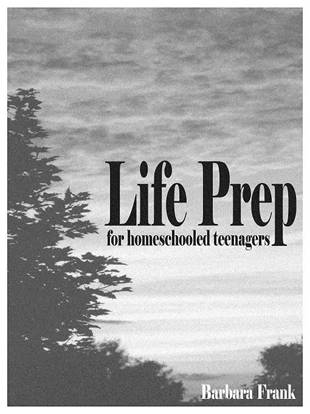The transition from homeschool to the larger world--whether it be college, the world of work, or marriage—sometimes comes as a shock to young people, especially if parents have not required their teens to assume much responsibility. Author Barbara Frank highlights two areas that seem to present the most trouble: money and relationships with others.
Life Prep focuses on these two problem areas, helping young people prepare for transition in advance with a two-pronged strategy: reading and projects.
For "recommended reading," annotated lists include both books and video recommendations under the thematic headings: books about living, resources about living, books about financial freedom, resources about financial freedom, books about investing, and books about the working world.
Three themes are reflected in both Life Prep and most of the suggested resources:
- Traditional values and ethics in the workplace
- Financial knowledge, frugality, and a cautious attitude toward unnecessary debt
- Christian worldview as it relates to families, work, and money
Consequently, among recommended books are those such as How to Be Your Own Selfish Pig by Susan Schaeffer Macaulay that challenges young people to examine their worldview and I Kissed Dating Goodbye by Josh Harris on a Christian view of dating and relationships.
The descriptions of each book within Life Prep will help you choose which books or videos are most suitable for each teen.
Projects help students understand the realities of being financially independent and responsible, and they also include instruction on how to write a college application essay since that might be a major part of the transitioning process. Other projects dealing with subjects like credit cards, car purchasing, health insurance, food expenses, budgeting, and mortgages require students to research and data comparison, including mathematical calculations. Some of the pages in Life Prep serve as worksheets for the projects.
The latest edition of this book (2007) adds a "Financial Freedom" project, a section on part-time work for students, and more on credit cards.
I especially appreciate the way Barbara has written this book making it super easy to use. The introductory information clearly and briefly explains Life Prep and how to use it. The introduction includes suggestions for reading and projects depending upon whether a student is college bound or not, and how much of the book to use depending upon the time available. I also like the total flexibility to choose just the books and projects (or parts of projects) that are helpful.
In practical homeschool fashion, Barbara recognizes that most parents won't be able to read every book their teen reads, so she suggests essays and note-taking assignments for feedback when discussion isn't practical. In the appendix, she also includes a set of ten essay questions that might be used with one recommended book, Your Money or Your Life. Also, most projects are designed such that they require minimal input from parents. Students will do most of their work independently.
It would be great if parents would start using some of the books and projects with teens in the early years of high school so there is time to cover all the important topics. But even in the last year or two of high school, there should be time to cover key books and projects.
Both because of the content and the design, I think homeschoolers are likely to find this one of the most practical and important resources for high school.
Note: This book was updated in 2017, but I have not seen the latest edition.









